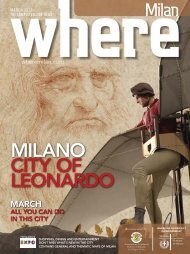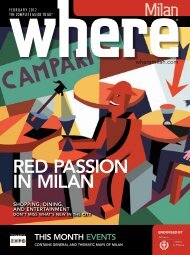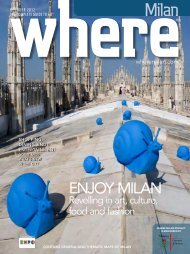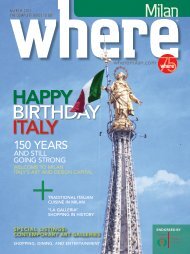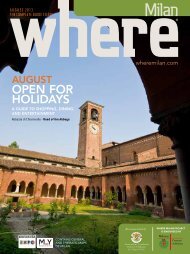CELEBRATING 75 YEARS OF WHERE - Where Milan
CELEBRATING 75 YEARS OF WHERE - Where Milan
CELEBRATING 75 YEARS OF WHERE - Where Milan
Create successful ePaper yourself
Turn your PDF publications into a flip-book with our unique Google optimized e-Paper software.
Exploring <strong>Milan</strong> and surrounding areasThe “Navigli”,a Waterway to the SeaA “NOT-TO-BE-MISSED “STOPOVER. Are you lookingfor a unique way of discovering <strong>Milan</strong>? Then take alook at it from the water. Although there is no sea in<strong>Milan</strong>, between 1179 and the Napoleonic era, it boastedhundreds of kilometres of Navigli or canals (most ofthem were built by Leonardo da Vinci) connecting it toLake Maggiore, Lake Como, the Ticino river and, finally,through the river Po, to the sea. Today, the only traces ofthat enormous network of waterways are the NaviglioGrande, the Paderno Canal, the Bereguardo Canal, thePavia Canal, and the Martesana Canal. The Darsena(Docks) is one of the most picturesque districts in <strong>Milan</strong>and its basin is one of the few remaining evidence ofthe vast system of canals and waterways in <strong>Milan</strong>. Takinga walk or bicycling along the Navigli is a truly enjoyableexperience. Conversely, another option is to immerseyourselves in the old-world atmosphere of times goneby taking a boat trip on the Navigli.REMNANTS <strong>OF</strong> HISTORYThe Navigli were highly strategic and used to irrigatethe fields, for trade and to transport the enormousmarble blocks required to build the Duomo. In 1482,Leonardo da Vinci was commissioned by the Duke of<strong>Milan</strong> to solve the problem of the differences in levelwhich he did by devising a system of sluices that canstill be seen today. His sketches for the project are preservedin the Museo dei Navigli (Brera, via San Marco40. Map F2). Several of them can also be seen in hisfamous Codex Atlanticus (Biblioteca Ambrosiana, seeThe Guide – Museums & Attractions). The Navigli werecompleted centuries later by Napoleon, only to fall intodisuse when the train system took over.Lombardy waterways (XVIII century)20 <strong>WHERE</strong> CITY NAME I JANUARY 2011




